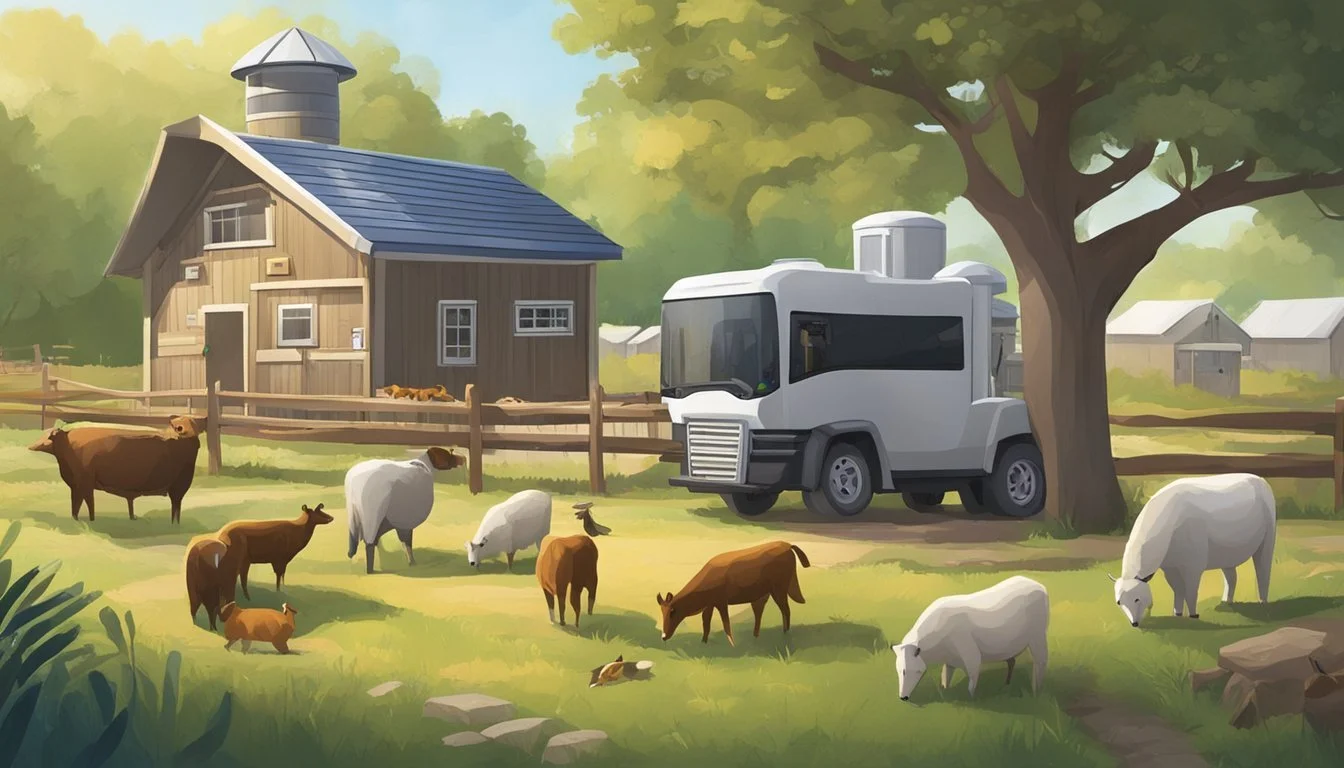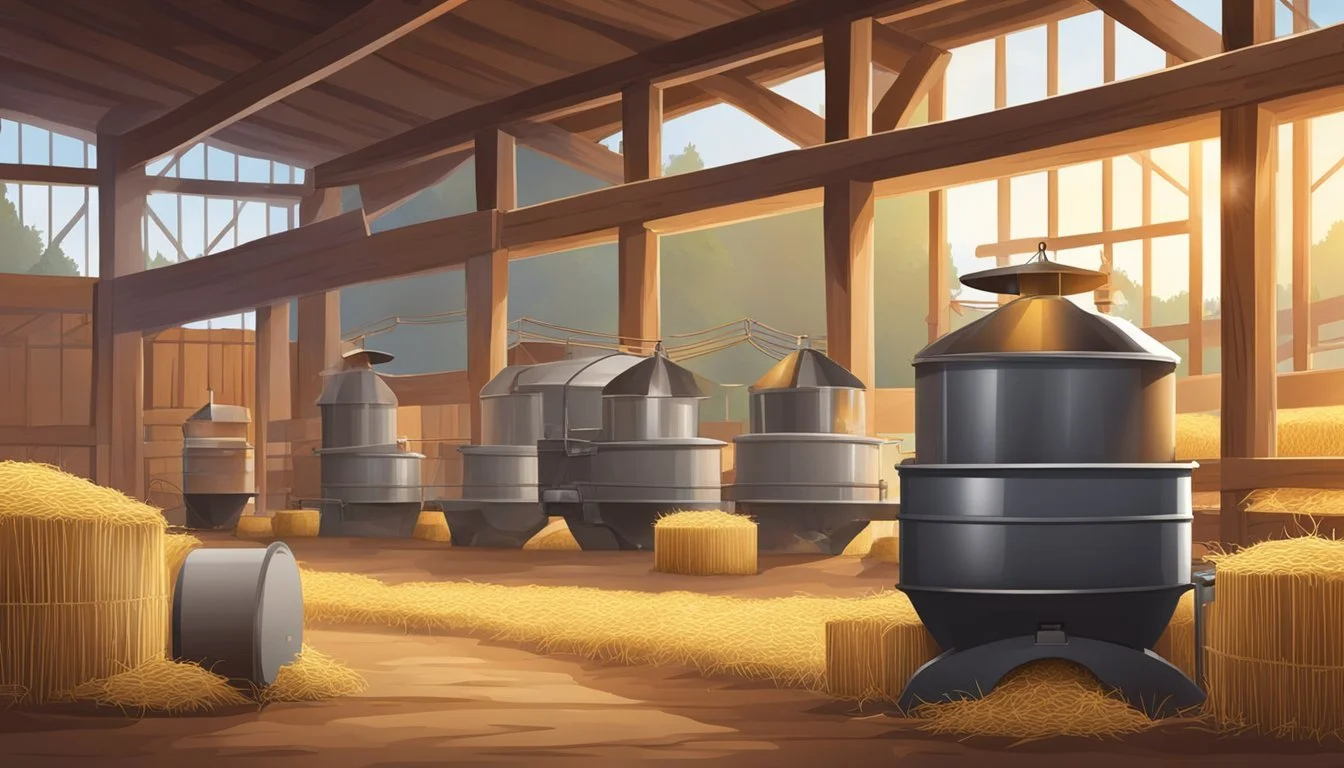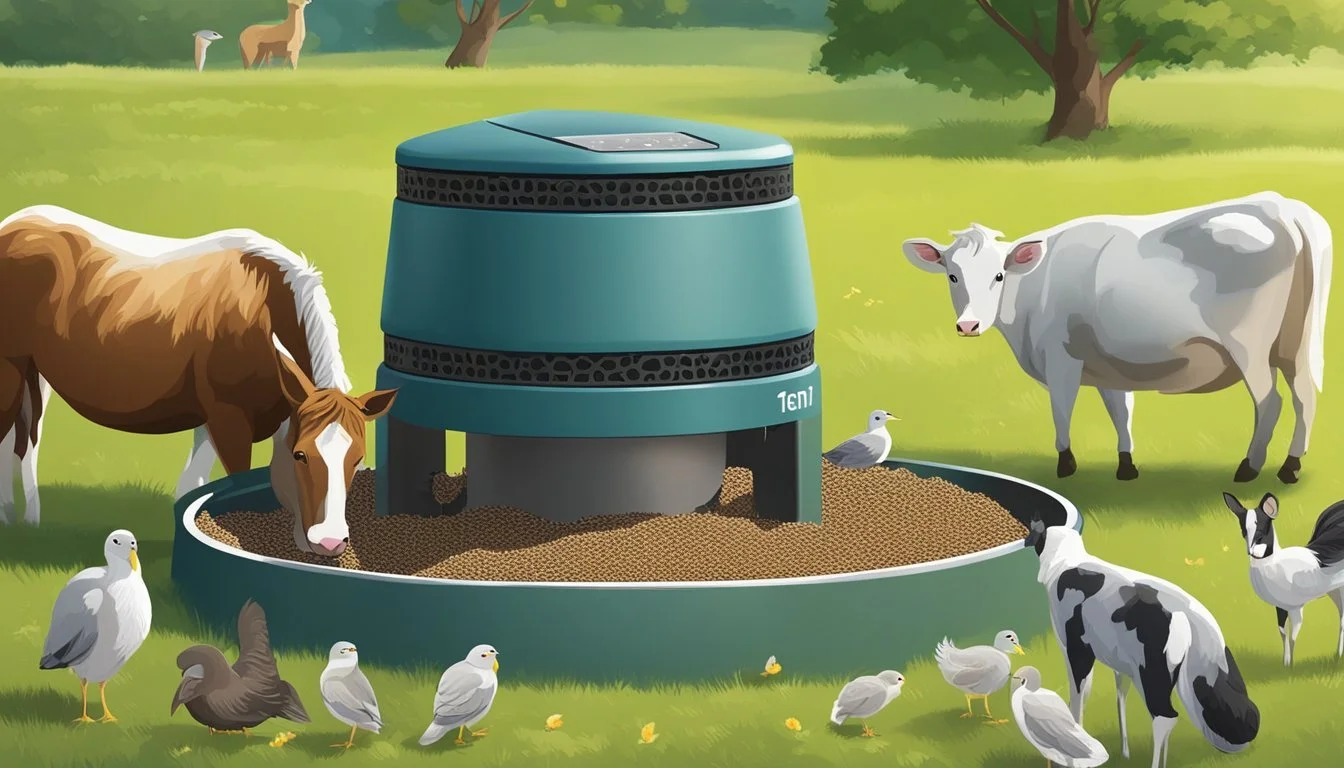The Ultimate Guide to Automatic Animal Feeders
Streamline Your Homestead's Feeding Routine
Automatic animal feeders are transformative tools for homesteaders who seek to ensure their animals are consistently and accurately fed, even in their absence. These devices provide a reliable solution to the daily demands of animal care, offering peace of mind to the owner and routine nourishment to the animals. With an array of options capable of dispensing different types of feed, including pellets from 1/8 inch to 1/2 inch, they cater to a variety of animals, from fish in a pond to livestock in a barn.
The implementation of automatic feeders can lead to a multitude of benefits such as improved health and growth rates of the animals due to regular feeding schedules. Modern feeders are often equipped with advanced timers and can accommodate up to 24 feeding times per day, with durations that can be customized to suit the specific needs of each animal. This precision not only fosters the well-being of the animals but also minimizes food waste and overfeeding, contributing to a more sustainable and cost-effective management of the homestead.
Selecting the appropriate feeder is dependent on several factors, including the type of animal, the size of the feed, and the homesteader's availability. While some feeders are straightforward with basic timers, others may boast sophisticated features such as Wi-Fi connectivity and mobile app integration, allowing for real-time monitoring and adjustments. It is the intersection of convenience, control, and care that makes automatic animal feeders an indispensable asset for modern homestead management.
Understanding Automatic Animal Feeders
In the realm of animal care, automatic feeders have revolutionized feeding routines by offering a consistent and hassle-free way to ensure pets are fed on time. This introduction will explore the different types of feeders, their technological advancements, and how to select the proper size and capacity for your animals.
Types of Automatic Feeders
There are multiple varieties of automatic feeders each designed to accommodate different lifestyles and pet needs. The most common include:
Programmable hopper feeders: Suitable for dry food, these devices allow for precise portion control and can be scheduled for multiple feedings throughout the day. The PetSafe Healthy Pet Simply Feed is a popular model noted for its reliability and customizable feeding options.
Gravity feeders: These feeders, like the Petmate Replendish Gravity Feeder, use gravity to replenish the food bowl as it becomes empty. They are a simpler option without the need for programming.
Smart feeders: These utilize Wi-Fi connectivity and can be operated via mobile apps. They often include features like cameras or an infrared sensor to monitor feeding, as with the WOpet Automatic Pet Feeder that supports customization via a smartphone.
Technology in Feeding
Modern automatic feeders seamlessly integrate with smart home technologies. Wi-Fi-enabled feeders offer the ability to adjust feeding schedules and monitor pets remotely. Features like HD cameras add an additional layer of interaction, enabling pet owners to observe their pets during mealtime.
Selecting the Right Size and Capacity
Selecting the right feeder involves considering the size of your pet and the kibble sizes it eats. The capacity of the feeder, which can range from a few cups to a week's worth of meals, should align with the pet's eating habits and owner's refilling preferences. For example, the PetSafe Healthy Pet Simply Feed Automatic Feeder has a large capacity that is adjustable to suit your pet's needs. Durability is also a crucial factor to ensure the feeder withstands frequent use and interaction with the pet.
Benefits of Using Automatic Feeders
Automatic feeders streamline the feeding process on a homestead by providing pet owners with control over feeding schedules and portion sizes, while also accommodating the challenges of a busy lifestyle.
Consistent Feeding Schedules
Automatic feeders ensure consistent feeding schedules, delivering food to animals at the same times every day. This regularity is not only beneficial for the pets' routine but also essential for their health and well-being.
Key Points:
Stable Routine: Pets thrive on routine, with predictable feeding times contributing to a sense of security and order.
Health Benefits: A set feeding schedule helps regulate pets' digestive systems and can prevent anxiety related to feeding uncertainty.
Preventing Overeating and Obesity
The precise meal programming of automatic feeders helps combat overeating by dispensing the correct amount of food for each meal, which plays a critical role in weight management for pets.
Key Points:
Portion Control: Accurately measured portions are dispensed, ensuring pets receive the recommended intake for their size and breed.
Obesity Prevention: By controlling the portion size, automatic feeders aid in preventing obesity and related health issues.
Flexible Feeding for Busy Pet Parents
Automatic feeders provide flexibility for pet parents with busy schedules, giving them the peace of mind that their pets will be fed on time, even when they cannot be there to do it themselves.
Key Points:
Peace of Mind: Pet parents can leave the home knowing their pets will receive their meals as scheduled.
Convenience: Feeders with advanced features such as Wi-Fi connectivity offer remote management, making it easier to adjust feeding times and portion sizes as needed.
Design Features to Consider
When selecting an automatic animal feeder, it's crucial to consider specific design features that accommodate various types of food, ensure ease of cleaning, and offer durability. The right combination of these characteristics can significantly enhance the feeding experience for your animals.
Types of Food Accommodated
Automatic feeders should cater to the specific dietary forms of the intended pet. Dry feeders are optimized for dry kibble, while models that handle wet food or semi-moist food will have sealing capabilities to maintain freshness. Some feeders are designed to manage a mix of wet or dry food, and a few can even dispense fresh food or canned food. It's imperative to match the feeder with the pet's diet.
Ease of Cleaning
To maintain hygiene and the health of your pets, cleaning should be a simple task. Look for easy to clean feeders where components can be disassembled quickly. Models with dishwasher-safe parts are highly beneficial. Feeders with a stainless steel bowl or surface are recommended as they are easier to sanitize and resistant to food residue build-up.
Durability and Materials
Durability is a direct consequence of the materials used in feeder construction. Feeders should be made from robust, non-toxic materials that can withstand the wear and tear of daily use. Stainless steel bowls are preferred for their longevity and resistance to scratching or denting. The body of the feeder may be made from durable plastics or metals that are tough enough to resist breaking or damage from outdoor elements or an animal's playful behavior.
Operational Considerations
Automatic animal feeders offer precise and regulated feeding solutions for homesteaders aiming to maintain consistent feeding schedules. However, the integration and ongoing operations of these systems hinge on several critical factors to ensure they deliver the intended benefits effectively and reliably.
Power Supply and Batteries
Most automatic feeders are powered either by a direct power source such as electricity or by batteries. The choice between a powered feeder and a battery-powered option often depends on the location of the feeding area and access to outlets. For uninterrupted operation, especially in the case of power outages, a double power supply that includes both electricity and a battery backup can be highly beneficial, ensuring that the feeder remains functional and the animals are fed on time.
Ease of cleaning: Ensure the feeder's power components are safely secured and protected to facilitate easy cleaning without damage.
Adjusting Portion Sizes and Meals
Portion control is a vital feature of automatic feeders, enabling the user to set specific feed amounts per meal. This is important for maintaining a healthy diet for animals and preventing overeating. The system should allow for easy adjusting of portion sizes to cater to the individual needs of different animals. This can be manually set on the feeder or via a mobile app for smart feeders with Wi-Fi connectivity.
List of steps to adjust portions:
Access the portion control settings through the physical interface or app.
Input the desired weight or volume of feed per portion.
Confirm the settings and ensure they are saved correctly.
Monitoring and Smart Features
Monitoring capabilities of an automatic feeder include features such as cameras, which allow for remote viewing of the animals during feeding times. More advanced feeders may offer smart features that connect to Wi-Fi and integrate with mobile apps, providing notifications, tracking feed levels, and allowing for remote adjustments to feeding schedules. Such features enhance the control owners have over their feeding operations.
List of monitoring features to consider:
Cameras for visual monitoring
Wi-Fi connectivity for remote access
Mobile app integration for notifications and tracking
Considerations for Different Pets
When setting up automatic feeders on a homestead, it is crucial to consider the specific needs of different animals to ensure their well-being and the smooth operation of the system.
Catering to Multiple Pets
For multi-pet households, it’s essential to find a system that can accommodate the feeding schedule and dietary needs of each pet. Hopper feeders can be beneficial as they can hold multiple meals, useful for feeding several pets at different times. Programmable feeders, such as the PetSafe Six Meal Feeder, allow for custom meal plans catering to each pet's unique dietary requirements. When using common feeders for multiple pets, it is important to ensure that food portions and accessibility suit all.
Special Needs: Kittens and Older Cats
Kittens and older cats have specific nutritional needs, with kittens requiring frequent small meals to support their growth and high activity level, and older cats often needing a controlled diet to manage weight. The use of an automatic feeder like the SureFeed Microchip Pet Feeder can help regulate the amount and frequency of food dispensed, which is particularly beneficial for kittens who need to eat more often. This technology ensures that each feline friend receives the right amount of food based on their life stage.
Preventing Food Theft Among Pets
Inter-pet food theft can be a significant issue in multi-pet households, particularly when there’s a mix of different species or breeds with varying appetites. An automatic feeder with microchip recognition, like the SureFeed Microchip Pet Feeder, ensures that only the designated pet can access the food, based on their implanted microchip or RFID collar tag. This can prevent other pets from stealing food and help maintain a peaceful feeding environment, as well as proper portion control for each pet.
Maintenance and Upkeep
Maintaining an automatic animal feeder is crucial for its durability and optimal functioning. A strict adherence to regular cleaning schedules, efficient battery and power management, and troubleshooting common issues will ensure consistent and easy feeding on any homestead.
Regular Cleaning Schedule
Regular cleaning not only ensures hygiene but also extends the lifespan of the feeder. Owners should:
Weekly: Wipe down the exterior with a damp cloth.
Monthly: Disassemble removable parts and wash with warm, soapy water.
Quarterly: Check for wear and tear or parts that may need replacement.
Emphasize the ease of cleaning by choosing feeders with fewer crevices where food and dirt might accumulate.
Battery and Power Management
For battery-powered feeders, managing power is key to avoiding disruptions in feeding schedules. Users should:
Replace batteries every 3 to 6 months, or as indicated by the device.
Consider using rechargeable batteries to reduce waste and save on costs.
Have a backup power source available in case of power outages, such as an Uninterruptible Power Supply (UPS).
Troubleshooting Common Issues
Encountering issues with an automatic feeder is common, and timely troubleshooting can prevent them from becoming major problems. Users should:
Jamming: Check and clear any blockages in the dispensing mechanism.
Irregular Dispensing: Verify that the programming is correct and adjust as needed.
Non-responsive Unit: Ensure connections are secure and reset the device if necessary.
Experts suggest keeping the user manual handy for specific troubleshooting tips related to the model in use.
Cost Considerations
When incorporating automatic feeders into a homestead, understanding the financial implications is as important as the technology itself. One must carefully evaluate the cost versus the features offered, the value added to pet feeding routines, and the potential long-term savings and return on investment these devices may provide.
Analyzing Price vs. Features
Automatic feeders vary widely in price, often correlating with their range of features. A basic model may start around $30, offering timed dispensing of food. On the other end of the spectrum, high-tech, smart feeders with multiple functions such as portion control, voice recording, and app connectivity can rise well over $150. A detailed comparison should include:
Functionality: Does the feeder simply release food, or does it adjust the quantity based on the animal's age, size, and dietary needs?
Durability: Higher-priced models are often more durable, constructed from quality materials that withstand frequent use.
Connectivity: Smart feeders' may provide valuable insights into feeding routines through data monitoring and offer remote control, contributing to a slightly higher price.
Finding Value in Pet Feeding Technology
The value of an automatic feeder transcends its price tag by offering convenience and peace of mind. For those with busy schedules, an automatic feeder ensures pets are fed on time, becoming an integral part of the daily routine. Features offering the most value include:
Remote Management: Having the ability to manage feeding routines while away adds immense value for pet owners, maintaining consistency irrespective of changes in their schedule.
Notifications & Alerts: Some feeders send notifications when food levels are low or when the feeder dispenses, keeping the owner informed.
Long-term Savings and ROI
Investing in a more expensive automatic feeder may seem steep initially, yet the long-term savings can be significant. Calculation should consider:
Reduced Waste: Accurate dispensing minimizes food waste, saving money on feed in the long run.
Energy Efficiency: Many automatic feeders are battery operated or consume minimal electricity, incurring low energy costs.
Labor Cost: Especially on a larger farm, the reduction in labor can outweigh the cost of the technology, as feeders help to automate the feeding routine.
By analyzing these cost elements, homesteaders can determine the most financially prudent choice that doesn't compromise on the quality of care for their animals.
Conclusion
In this guide, the intricacies of choosing and using automated pet feeders to maintain consistent feeding schedules for animals have been thoroughly examined.
Recap of Automatic Feeder Benefits
Automated pet feeders ensure that pets are fed regular meals even when their owners are away. Key benefits include:
Consistency in Feeding: Meals are dispensed on schedule, ensuring pets eat at the same time every day.
Portion Control: It prevents overfeeding, as the feeder dispenses specific amounts of food.
Convenience: They save time and worry for pet owners, as manual feeding is no longer a daily requirement.
Final Thoughts for Pet Owners
Choosing the best automatic dog feeders or other pet feeders should be a carefully considered decision. One should look for models that can handle the specific dietary needs of their pets, including portion size and frequency of feeding. Durability, the reliability of the feeding mechanism, and ease of cleaning are also important factors to consider to ensure pets are consistently cared for in the absence of their owners.









